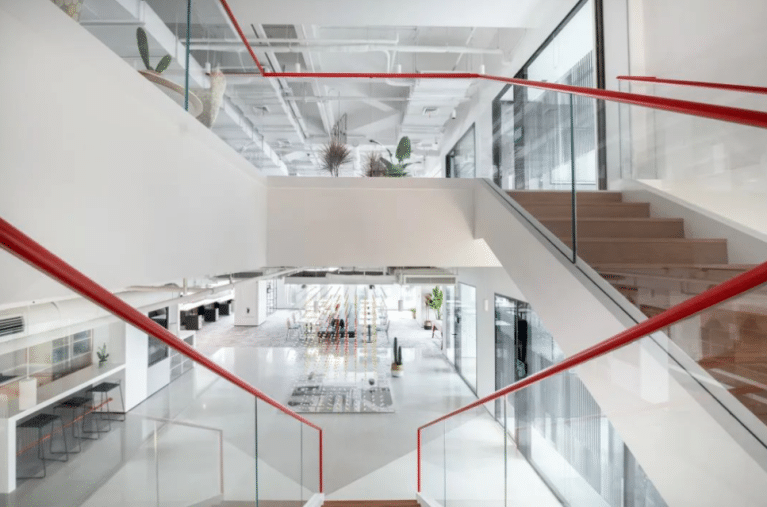隔音门怎么做隔音好?杰柏Studio系列按专业录音室标准打造,以STC 44卓越隔音性能有效阻隔交谈声。提供双层/单层玻璃灵活配置,超薄轻质设计颠覆传统,实现隔音功能与空间美学的无缝融合,让办公空间更静谧,打造高效舒适环境。
杰柏集团专注开放式办公室隔音方案,推出STACKADE隔音门,采用层叠面板设计,兼容多样风格,有效隔绝噪音。灵活隔断提升空间利用率,经济便捷,量身定制解决方案,打造舒适高效办公环境,满足开放式办公场景的隔音需求。
金融行业某跨国公司上海办事处落座上海中心地区,JEB 携手知名设计公司,共同为该办事处打造了一个既高效又富有现代感的办公环境,其中 X-Series办公室系统隔断成为了空间规划的核心亮点。
JEB杰柏专注办公空间设计,为香港置地广场York House国际律所打造静谧思想圣殿。深度定制声学策略,融合科技美学,确保专注私密,提升专业效能与品牌感知,是顶尖机构塑造竞争力空间的优选。
作为办公家具十大品牌,杰柏以匠心与可持续理念,提供全场景卓越空间解决方案。我们注重创意功能、健康呵护与团队协作,精选环保材料,为客户打造高效、健康、凝聚的工作生活空间,共塑绿色未来,引领办公家具行业新风尚。
办公隔断玻璃隔断采用JEB设计理念,实现动静分区,黑色与银色边框搭配浅米色木地板及浅灰色地毯,既促进团队协作又保障专注办公。通透隔断确保视觉延伸,打造开放包容、理性高效的专业办公环境,满足现代企业空间规划需求。
在西岸·绿洲,空间不仅是容器,更是激发灵感的能量场。当开放协作与独立思考成为现代办公的双重需求,如何精准划分空间而不割裂氛围?如何打造视觉通透却又静谧专注的环境?西岸·绿洲携手JEB杰柏,以玻璃隔断系列系列Summit door双层玻璃隔断为核心笔触,勾勒出纯净、沉静而细腻的办公新图景。
上海办公室玻璃隔断如何兼顾高效协作与空间美学?麦当劳香港办公室以JEB杰柏双层玻璃可操作墙为灵感,通过可切换玻璃面板与智能移动隔断,30秒实现开放会议区与独立研讨室的灵活转换,搭配品牌色与动态灯光,打造活力与专注平衡的协作场域。
JEB杰柏针对航空业办公空间需求,以创新防火隔音门及隔断系统提供解决方案。采用A类1小时防火双层玻璃隔断保障安全,X-series双层玻璃门有效隔绝噪音,金属质感框架与通透设计融合现代美学,技术赋能灵活适配未来需求,从安全、静音、美学到技术赋能全方位重塑办公空间,满足航空业严苛标准,成为理想之选。
杰柏会议室玻璃隔墙以卓越隔音性能与灵活组合设计,重新定义现代办公空间美学。在中国手游头部企业上海办公室项目中,JEB采用X-Series双层弧形玻璃隔断,实现功能分区独立性与空间流动性平衡,阳极氧化黑色工艺更赋予高级质感,成为功能与美学兼具的理想选择。
杰柏办公室玻璃隔断以A级防火隔热玻璃为核心,通过高强度钢结构支撑体系,打造集1-2小时耐火防护、创新消音技术与空间美学于一体的办公解决方案。产品突破传统隔音局限,为会议室等私密空间营造静谧环境,同时遵循国家标准满足多样化防火需求。
上海办公室玻璃隔断领域,JEB杰柏隔断以玻璃工艺为核心,融合艺术性、仪式感与品质感,打造高效功能分区与流动美学韵律。其极简设计减少框架存在,通透玻璃成为视觉主角,光影交织如艺术画廊。模块化设计支持灵活改造,兼顾声学性能与可持续空间生态,重新定义办公空间价值维度。
















